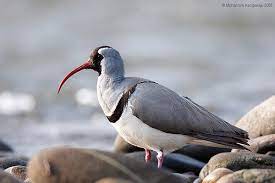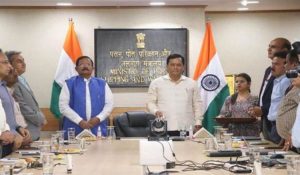Today’s Current Affairs: 27th March 2023 for UPSC IAS exams, State PSC exams, SSC CGL, State SSC, RRB, Railways, Banking Exam & IBPS, etc
Table of Contents
Disqualification Of Member Of Parliaments:

Congress leader Rahul Gandhi has been disqualified from the Lok Sabha recently.
Disqualification of Member of parliaments:-
- The provision for disqualification is given in Article 102 of the Constitution.
- It specifies that a person shall be disqualified for contesting elections and being a Member of Parliament under certain conditions:
- If he holds any office of profit under the Union or state government (except that of a minister or any other office exempted by Parliament).
- If he is of unsound mind and stands so declared by a court.
- If he is an undischarged insolvent.
- If he is not a citizen of India or has voluntarily acquired the citizenship of a foreign state or is under any acknowledgement of allegiance to a foreign state
- If he is so disqualified under any law made by Parliament.
- Article 102 also authorises Parliament to make laws determining conditions of disqualifications.
- There are analogous provisions for members of state legislatures.
Guillotine:

The ongoing stalemate in the Indian Parliament has led to the possibility of the government using ‘guillotine’ to fast-track the passage of the Finance Bill without any discussion in the Lok Sabha.
- This has led to confusion and questions about what exactly guillotine means in legislative parlance.
- The term guillotine originally referred to an apparatus designed for executions by beheading.
- It was introduced in France during the French Revolution to make capital punishment more reliable and less painful.
- In legislative parlance, guillotine means to bunch together and fast-track the passage of financial business.
- It is a fairly common procedural exercise in Lok Sabha during the Budget Session.
- Once the guillotine is applied, any remaining demands for grants are put to vote without further discussion.
- This ensures that the budget is passed within the allocated time, and the government can continue its work without any delay.
Abel Prize:

Luis Caffarelli has won the 2023 Abel Prize for his contributions to regularity theory for nonlinear partial differential equations, including free-boundary problems and the Monge-Ampère equation.
- The Abel Prize is a prestigious award in mathematics that recognizes pioneering scientific achievements in mathematics.
- It is named after Norwegian mathematician Niels Henrik Abel.
- The Norwegian Parliament established the prize in 2002, and it includes a monetary award of 7.5 million kroner (approximately $720,000) and a glass plaque.
- It is awarded by the Norwegian Academy of Science and Letters on behalf of the Ministry of Education of Norway.
Aravalli Green Wall Project:

The Union Minister for Environment, Forest and Climate Change launched the Aravalli Green Wall Project at a function organised to celebrate the International Day of Forests at Tikli Village in Haryana.
- Aravalli Green Wall Project is a major initiative to green the 5 km buffer area around Aravalli Hill.
- The Aravalli Green Wall Project is part of the Union Environment Ministry’s vision to create green corridors across the country to combat land degradation and desertification.
- The project covers the states of Haryana, Rajasthan, Gujarat and Delhi – where the Aravalli hills landscape span over 6 million hectares of land.
- The project will involve planting native species of trees and shrubs on scrubland, wasteland and degraded forest land, along with rejuvenating and restoring surface water bodies such as ponds, lakes and streams.
- The project will also focus on agroforestry and pasture development to enhance the livelihoods of local communities.
- Objectives of the Project:
- Improving the ecological health of the Aravalli range.
- To prevent the eastward expansion of the Thar Desert and to reduce land degradation by creating green barriers that will prevent soil erosion, desertification and dust storms
- Contribute to India’s commitments under various international conventions such as UNCCD (United Nations Convention to Combat Desertification), CBD (Convention on Biological Diversity) and UNFCCC (United Nations Framework Convention on Climate Change).
MSP For Jute:

The Cabinet Committee on Economic Affairs, chaired by the Prime Minister of India, has given its approval for the Minimum Support Price (MSP) for Raw Jute for the 2023-24 season.
- Jute is one of the most important natural fibres after cotton in terms of cultivation and usage
- India is the largest producer of jute followed by Bangladesh and China.
- It is mainly grown in eastern India because of the rich alluvial soil of the Ganga-Brahmaputra delta.
- In India, major jute-producing states include West Bengal, Bihar, Odisha, Assam, Andhra Pradesh, Meghalaya and Tripura.
- A minimum support price (MSP) is a minimum price for any crop that the Government considers as remunerative for farmers and hence deserving of “support”.
- It is also the price that Government agencies pay whenever they procure a particular crop from the farmers.
- There is currently no statutory backing for these prices, nor any law mandating their enforcement.
OSIRIS-Rex Mission:

NASA’s OSIRIS-REx spacecraft is on the final leg of its two-year journey back to Earth after collecting samples from the rocky surface of the asteroid Bennu which will touch down in a desert in Utah on September 24, 2023.
OSIRIS-Rex Mission:
- The Origins Spectral Interpretation Resource Identification Security – Regolith Explorer was launched by NASA in 2016 for the journey to Bennu.
- The spacecraft travelled to a near-Earth asteroid called Bennu and bring back a sample to Earth for study.
- The mission will help scientists investigate how planets formed and how life began, as well as improve our understanding of asteroids that could impact Earth.
- Asteroid Bennu is located about 200 million miles away from the Earth.
- It was discovered by a team from the NASA-funded Lincoln Near-Earth Asteroid Research team in 1999.
- It is a B-type asteroid, implying that it contains significant amounts of carbon and various other minerals.
- Around 20-40 percent of Bennu’s interior is empty space and scientists believe that it was formed in the first 10 million years of the solar system’s creation, implying that it is roughly 4.5 billion years old.
- Bennu is believed to have been born in the Main Asteroid belt between Mars and Jupiter and because of gravitational tugs from other celestial objects and the slight push asteroids get when they release absorbed sunlight, the asteroid is coming closer to Earth.
Vedic Heritage Portal : New Delhi

The Union Home Minister inaugurated the Vedic Heritage portal in New Delhi
- Vedic heritage portal is developed by the Indira Gandhi National Centre for the Arts
- The portal will be a one-stop solution for the user, who would like to search for any information regarding the Vedic heritage.
- The audio-visual recording of four Vedas has been uploaded on the Vedic Heritage portal. The portal has over 18 thousand mantras of the four Vedas with a duration of over 550 hours.
- The objective of the portal is to secure knowledge from ancient scriptures and manuscripts for future generations through technology.
- Indira Gandhi National Centre for the Arts was established in 1987 as an autonomous institution under the Ministry of Culture, as a centre for research, academic pursuit, and dissemination in the field of the arts.
- It has a trust (Board of Trustees), which meets regularly to give general direction about the Centre’s work. The Executive Committee, drawn from among the Trustees, functions under a Chairman.
National Initiative For Promotion Of Upskilling Of Nirman Workers (NIPUN) Scheme:

The National Initiative for Promoting Upskilling of Nirman workers (NIPUN) has recently completed its training program for construction workers engaged in the Central Vista project in New Delhi.
- NIPUN Scheme is an innovative project for the skill training of construction workers.
- It is an initiative of the Ministry of Housing & Urban Affairs (MoHUA) under its flagship scheme of the Deendayal Antyodaya Yojana-National Urban Livelihoods Mission (DAY-NULM).
- Objective: To train over 1 lakh construction workers through fresh skilling and upskilling programmes and provides them with work opportunities in foreign countries
- The National Skill Development Corporation (NSDC), the nodal agency under the Ministry of Skill Development & Entrepreneurship (MSDE), Government of India, will be the Implementation Partner for the project NIPUN.
- The project implementation is divided into three parts:
- training through Recognition of Prior Learning (RPL) at construction sites;
- training through Fresh Skilling by Plumbing and Infrastructure Sector Skill Council (SSC);
- International Placement through industries/ builders/ contractors;
- The courses are aligned with National Skills Qualifications Framework (NSQF) and will be imparted at accredited and affiliated training centres.
- It will provide trainees with ‘Kaushal Bima’, three-year accidental insurance with coverage of Rs 2 lakhs.
Anji Khan Bridge:

According to officials, the last deck portion of the Anji Khan bridge is expected to be completed soon.
- Anji Khan Bridge is an under-construction railway bridge in the Reasi district of Jammu and Kashmir.
- It will be the first cable-stayed railway bridge in India.
- It forms a part of the Udhampur Srinagar Baramulla Rail Link Project (USBRL) connecting Katra and Reasi Station on the Jammu-Baramulla line.
- It is an asymmetrical cable-stayed bridge balanced on the axis of a central pylon, and it has tunnels on both ends.
- The cable-stayed portion of the Anji bridge is 472.25 metres, while the total length of the bridge is 725.5 metres, which is divided into four parts, including an embankment.
- The central span of the bridge is 290 metres; its total deck width will be 15 metres.
- It stands at the height of 331 metres above the Anji river bed.
- Trains can run up to 100km/h, and the bridge can withstand wind speeds up to 213 km/hr.
Ibisbill:

Researchers recently highlighted that ground-nesting birds, including the ibisbill, can be impacted by changing climatic patterns in the Indian Himalayas.
- Ibisbill is a bird which belongs to the family Ibidorhynchidae. It is the only species in this family.
- It is a charismatic and uncommon wader seen in the Himalayas and foothills of India.
- Scientific Name: bidorhyncha struthersii
- They are common in Central Asia and the Himalayas.
- They are found in India, Pakistan, Afghanistan, Uzbekistan, Kazakhstan, Turkmenistan, Tajikistan, Kyrgyzstan, Nepal, Bhutan, Myanmar and China.
- It lives at high altitudes near rivers.
- They exhibit altitudinal migration, breeding in the higher reaches of the mountains and descending to lower elevations during winters.
- It is a medium-sized wader, measuring 38 to 42 cm in length and weighing 270 to 320 grams.
- It has a long, downward curved and sharply-pointed pink bill; a grey body; a white belly with a black band on its chest; and a black face.
- The sexes are similar, which makes this species monomorphic as well.
- They are good swimmers.
- Conservation Status: IUCN: Least Concern
Sagar Manthan Dashboard:

The Ministry of Ports, Shipping and Waterways (MoPSW) launched Sagar Manthan dashboard.
- Sagar Manthan Dashboard is the Real-time Performance Monitoring Dashboard of MoPSW that will monitor and track the progress of their projects.
- This new digital platform has integrated all the data related to the Ministry and other subsidiaries.
- Features:
- Data visualization
- Real-time monitoring
- Improved communication
- Data-driven decision making
- Increased accountability
- The dashboard is a positive development towards Digital India vision.
- It will ensure the timely completion of projects, informed decision-making, increased efficiency & effectiveness of projects
- It will also promote risk management, resource allocation, and progress reporting.
Earth Hour:

Millions of people across countries recently celebrated Earth Hour.
- Earth Hour is a global grassroots movement uniting people to take action on environmental issues and protect the planet.
- It is organized by World Wildlife Fund (WWF).
- It was started by WWF and partners as a symbolic lights-out event in Sydney in 2007.
- It takes place on the last Saturday of March every year.
- “Earth Hour” encourages people to switch off all lights for an hour, from 8:30 pm to 9:30 pm local time to promote awareness of climate change challenges and energy conservation.
- Governments and companies also participate by turning off non-essential lights in their buildings, monuments, and landmarks to raise awareness about the impact of energy consumption on our planet.
- This symbolic act, known as the ‘lights off’ moment, unites people worldwide in a show of support for the planet and serves as a reminder of the environmental issues facing us.




